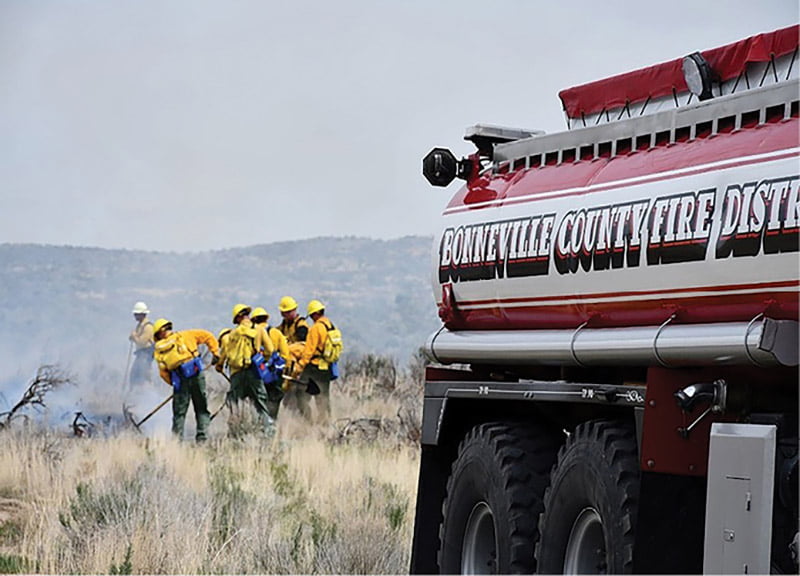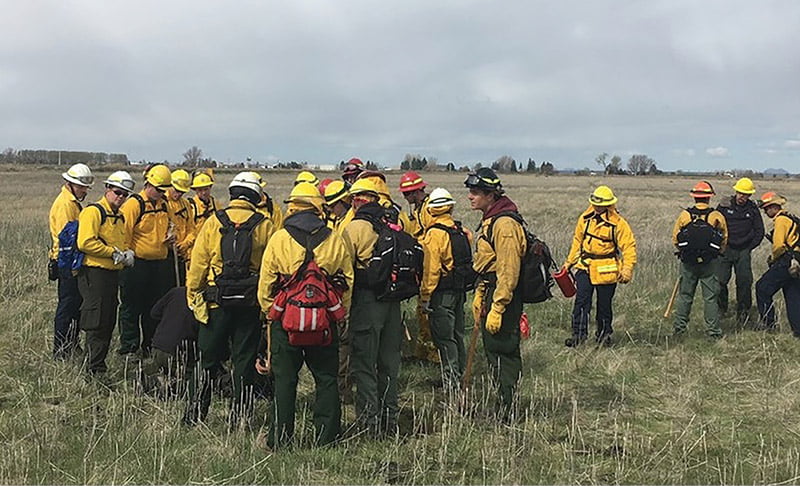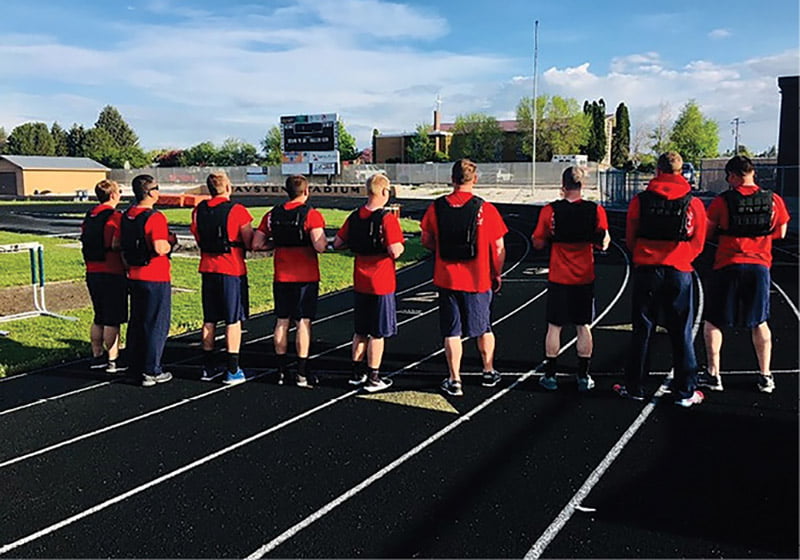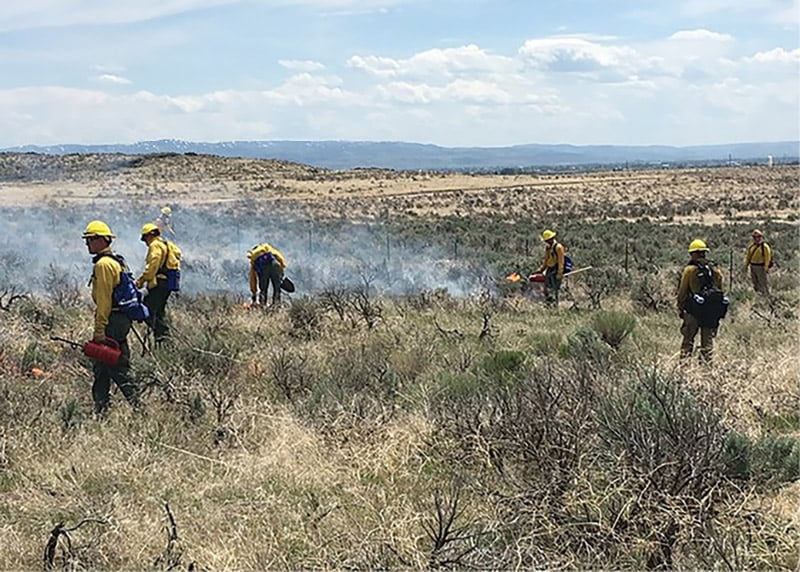Gone are the days of a fire season that is built around the summer months; it is now all year long. It’s also time to look past the thought of, “It will never happen to us.” Pick any day of the week, month, or weather season, and you will see fire service organizations responding to wildfires everywhere. Any firefighter who has been involved in wildland fire response of some type has almost certainly heard the acronym LCES—Lookouts, Communications, Escape routes, and Safety zones.
It doesn’t matter if you are a volunteer or career firefighter or if you are in the Southeast or the Northwest, municipal fire departments of all types and sizes are heading into the wild to suppress a fire that doesn’t care about jurisdictional boundaries. The fire doesn’t pay attention to your organization’s experience level or what color your apparatus is.
A New LCES
The LCES concept was originally developed by Paul Gleason of the U.S. Forest Service (USFS). Gleason was a Zig-Zag Interagency Hotshot superintendent who saw death in the wildland fire environment and vowed to make a change. Firefighters can use the LCES acronym to help decrease the potential of a burnover or shelter deployment incident in the wildland fire response. It also allows any firefighter to act as a lookout, provide appropriate communications related to the fire environment, and help other firefighters develop risk mitigation considerations in establishing escape routes and safety zones. However, for this article, we will look from a “30,000-foot view” of leading and managing the wildland fire response. As someone who may be in that role, how can you do a better job in managing the resource or providing firefighters with the ability to operate safely, efficiently, and effectively?
Using the same acronym of LCES but for a different purpose, we can create a wider variation of what it can mean:
- Levels of experience,
- Communications/Certifications,
- Equipment standards, and
- Staffing models.
If you have ever been in the role of incident commander (IC), task force leader, strike team leader, structure protection specialist, division supervisor, or even group supervisor, you will know that not all firefighters—or fire departments—are created equal. When a fire service organization (FSO) says, “Let’s start going on assignments off our district to make some dollars … or gain some experience,” you may get a volunteer or combination department with lots of experience and exposure because of the district type or you may get a large career department with very little experience in this world that is struggling to play catch-up from the moment “go.”


(1) Multiple agencies participate in annual prescribed fire activities and training around the Idaho Falls, Idaho, area. Light, flashy fuels and brush make up a significant portion of the south Idaho area. Supporting the firing operation is a Type 1 tactical tender [a heavy expanded mobility tactical truck (HEMTT)] with 3,300 gallons of water on an 8×8 frame. (Photos by author.)
All of this can be a recipe for disaster—or success. So, as the IC of the emerging incident or long-term assignment leader or manager, you can prepare in your mind what you can do for strategy and task management with what you have coming your way.
Levels of Experience
Some career and volunteer firefighters and fire departments have a lot of experience in the wildland response, while some have very little. Some wildlands have complex fuel environments, and some have less complexity. Whether the setting is grass, brush, or timber, add in the wildland urban interface (WUI) and things change even more. Throw in the normal season for one area of the country and then think, “When it’s over, prepare for when it’s not.”
For example, look at what the Great Falls (MT) Fire Department experienced in December 2021: a 120-acre grass fire in December! During that month, several fire departments in Montana experienced numerous grass fires that struck both commercial and residential structures. Also consider the Marshall Fire in Colorado: More than 1,000 structures and more than 6,000 acres were lost, the same month, same year, during the same weather season—winter!
Next, consider if an FSO had previously worked with a state or federal wildfire agency such as the USFS or the Bureau of Land Management (BLM). If the FSO has not previously worked with a state or federal fire program, the level of associated risk increases. Because most state and federal agencies have a new level of standards and terminology with which to become familiar, and their experience in dealing with wildland fires is also on a different level than a volunteer or career agency that sees just a few wildfires a year or a catastrophic, once-in-a-career event, all of these thoughts above are simply the beginning of generalizations.
If a fire department crew approaches me as a task force leader or an IC at a wildland incident, I would assess their experience based on their clothing or the vehicle in which they arrived. If they lacked experience or exposure to what’s needed because, “We have always done it this way,” the risk profile changes for the operation based on their past experiences and exposure to complex operations. Also, if we are in the wildland fire environment and fire crews show up wearing full structure gear, nonwildland boots, and so on, I prepare for challenges.
On the flip side, states like Montana and Colorado normally have state and federal agency wildland firefighters available to assist in these situations during prime fire season. However, winter is not “prime” fire season, so these resources aren’t normally available.
Also, having land management agencies, which get a lot of wildfires, respond and participate can help less experienced firefighters and municipal departments gain more experience in numerous operational situations. So, these organizations had to quickly use all hands available to assist them. Because of this, the potential for less experienced personnel to be called on to assist in the fire suppression effort now exists.
How many municipal firefighters have direct communication experience with wildland fire aircraft? Unless they do it on a regular or semi-regular basis, the IC is going to struggle talking to an airtanker pilot or helicopter coming in with a bucket. Again, experience is critical for some of the many things in a rapidly changing and evolving environment that can kill people in a split second. One way to combat this is to position-share with wildland fire agencies. A municipal firefighter should spend time with a wildland firefighter the same as when emergency medical technicians from the USFS, the BLM, and the National Park Service ride with career and volunteer fire and EMS agencies to gain experience. It’s all about getting some seat time that helps prepare for success.


(2) The Idaho Falls Fire Department uses multiple U.S. military 8×8 HEMTTs for converted Type 1 tactical tenders: 2,500-3,300 gallons, pump-and-roll capabilities, dual booster lines, front and rear water pods, a front-mounted monitor (remote controlled, variable gallons selectable), and a 30,000-pound PTO controlled winch. These are used in local jurisdiction responses as well as a nationally requested resource across the western United States.


(3) A WUI response in the Kamiah, Idaho, area. The land features heavy brush with a big timber component and hoarder conditions. There is limited hydrant availability, and water access can create issues for suppression.
Communications, Certifications, and Terminology
The primary reasons most things go wrong in the wildland fire environment are usually like a National Institute for Occupational Safety and Health’s (NIOSH’s) “Top Five” for a municipal fire gone wrong; one of them usually ties to a communication issue of some type. For instance, if you say “tanker” west of the Mississippi River, you will get an airplane with hundreds to thousands of gallons of water, mud, slurry, or the proper term “fire retardant.” If you say “tanker” east of the Mississippi, you will get a wheeled vehicle with thousands of gallons of water moving quickly, susceptible to a rollover, potentially hurting or killing a firefighter. This happens every year.
Next, if using frequencies that include UHF, VHF, 700, 800, or 900, you have the makings of interoperability gone wrong, all the time. Agencies across the country still cannot talk to one another, refuse to share frequencies, or simply cannot get along well enough to respect one another to share radio chatter. I know of one department where only the chief’s vehicle has a “wildland fire radio” and, if he was out of town, the vehicle didn’t roll, eliminating communications with other federal resources. Also, if you have critical fire environment information, say something before it’s too late; it might be for your or your crew members’ own good. The last thing anyone should experience is 3,000 gallons of red mud flying through the air and landing on a volunteer or career firefighter who didn’t know an air tanker was inbound for a drop.
Another example to consider is communicating the notice of a weather event, known as a “red flag warning.” Idaho’s Point Fire in 1995 is a prime example of where this warning would have saved lives. Here, a volunteer fire department was unaware of a “dry” thunderstorm that was quickly approaching. At the time, information was not communicated effectively between the local fire department and the federal land management agency. The local BLM was aware of the situation, but because they were not officially notified, two volunteers died on scene. The findings from the subsequent investigation showed this apparent critical lack of communication. Fortunately, things have changed. However, many FSOs still struggle with this concept. Even dispatch centers don’t relay this information to their agencies, making this a recipe for disaster.
Similar to the NIOSH Top Five is accountability, which includes certifications. Many firefighters in municipal fire departments still do not know what an incident qualification card (“Red Card”) is. How many have heard of the National Wildfire Coordinating Group (NWCG), which develops training and certification standards for wildland fire operations?
Many departments have said, “Wildland fire training is not needed. We are a structure department.” However, consider the rare March 2021 wildland fire in Lakewood, New Jersey, which involved an isolated amount of forest surrounded by residential and commercial structures and more than 30 fire departments responding. How many of those departments had wildland fire certificates of training? During this response, there was low relative humidity and high winds that added fuel to the fire for their typical fire season time frame. However, if you look at the fire departments across the United States that are responding to WUI fires, how many are following NWCG certifications or National Fire Protection Association (NFPA) training standards for wildland fire responses? Now, a chief can no longer say, “Well, I didn’t know.” No matter how you look at it, a lawsuit is still a lawsuit. Having your head in the sand of “not knowing” is not a defense for negligence.
Next, consider the previously mentioned municipal firefighter who suffered a cardiac event/heat-related injury while in full structure fire personal protective equipment (PPE) at a grass fire. Structure fire PPE increases core temperature, which then increases the risk for suffering a cardiac-related event. Again, the right thing to do is training and certifying to the nationally accepted standard for wildland fires. I understand and empathize with the departments that struggle to accomplish this, but we owe it to our people to strive for that. We won’t put someone in a structure response with self-contained breathing apparatus his first time without a training certificate of completion of some type. So, why would we do that for a wildland fire?
Recently, I saw an online video of a female firefighter who belonged to a volunteer organization riding on the front bumper of a brush engine, wearing a tank top, no gloves, and no helmet and spraying water on a “training grass fire.” When the subject of PPE, training, and equipment standards were brought up, her response was, “You going to pay for it for us?” When she gets hurt or killed because no one wanted to follow standards, will your fire department be able to afford the lawsuit? Better yet, are you going to be able to look that family in the eye and say you did everything to protect her? What are we communicating to the firefighters, the organization, and their families when we are unwilling to follow the training, certification, and response standards?
Equipment Standards
Structure engines are not wildland engines. Structure gear is not wildland PPE. Structural hose is not wildland hose; we could literally pick apart every aspect of this. Numerous studies have demonstrated that municipal firefighting clothing is big, bulky, and absolutely increases body temperature. And, with increased core temperature, we are simply increasing the risk for cardiac arrest, stroke, or heat-related illnesses. Double layering thick, heavy wildland jumpsuits or brush gear over regular clothing also adds layers of additional body heat to deal with. Subsequent NIOSH investigations have provided guidance that this is no longer appropriate, either. More appropriate PPE that meets NFPA 1977, Standard on Protective Clothing and Equipment for Wildland Fire Fighting and Urban Interface Fire Fighting, can help decrease this associated risk.


(4) Firefighters from multiple municipal fire agencies receive an operational briefing prior to a firing operation training activity for the NWCG S-219 Firing Operations course.
Although PPE is one (perhaps even the first) piece of the puzzle with how we take care of our firefighters, another involves apparatus. When firefighters show up to a wildland fire in certain vehicles, doing or not doing certain things, I start to see red flags—challenges are ahead. Firefighters riding on the outside or top of the apparatus while driving at “mach speed” through a smoke-saturated field is a concept that will take big change at levels of leadership everywhere. Making that transition will be a long time coming and filled with the traditional “This is the way we have always done it” statements. If members are going to ride apparatus, they must sit in a more appropriate place other than the front bumper or on top of the tank. And, although they are riding in that new spot behind the cab with roll protection and a restraining system, they must also use PPE that is more appropriate for the wildland fire environment; this includes fire shelters or protection screens for exterior personnel so when the flame front changes directions or leaps out at the guy riding in that spot, he has a fighting chance of survival.
As we begin to look at apparatus equipment types, consider the repercussions of not doing the right thing, again. Although everyone wants the newest, latest, and greatest, it’s unachievable for many organizations, both career and volunteer. Numerous departments have been using old surplus military equipment from years gone by. With that as their only option, it costs money to rebuild a fire apparatus and costs even more to maintain it. And, with more time comes the need for more money (in certain situations).
When a vehicle breaks down and firefighters are hurt or killed, it will cost more than just mere dollars; it will wreck the department as well as the community affected by it on multiple levels. So, as departments begin to look at updating fleets, they won’t always be able to buy something brand new. However, they can at least look at used equipment that is newer. For instance, a vehicle that is 20 to 25 years old or older will absolutely begin to cost more money in the long run.
Apparatus rolling into a wildfire without working seat belts or radios programmed with wildland fire agency frequencies while personnel sit on top of the tank, holding on for dear life, is another sign of negligence. Although your department may not be able to afford the newest and greatest, you may be able to buy a less expensive vehicle that serves two areas while your neighboring department buys the “bigger ticket” item that also serves two areas. We can auto-aid them to the call so that you get that water tender or that brush truck and don’t have to wait for mutual aid.
Staffing Considerations
For years, state and federal wildland fire management agencies have been struggling to maintain the once-coveted seasonal wildland firefighter positions (also known as “forestry technician”). These were the men and women going to college and looking for good work, a lot of overtime and hazard pay, and the ability to see things across the United States. Fewer people are signing up for these jobs because of inequality of pay by these organizations compared to municipal firefighters, less time off during the summer, and many other reasons. A downside to a seasonal-based workforce in today’s wildland fire environment is the increasing length of the season as well as layoffs. Then, when those obscure wildland fires happen in November, December, January, or February (or any month from your area), you have fewer state or federal agency partners to help. These state and federal programs have come to rely heavily on volunteer/combination/career departments for initial attack and off-district assignments, and all these departments and their firefighters began to see dollars and increased pay in their budgets. Breaking it down, we will see some issues across the board. There is a learning curve to understanding new terminology and the appropriate application of when to use it. It’s a struggle to get people to change, but when you add complications of working through a system that, at times, can be complex and arduous, it makes it even more challenging.
Thirty to 40 years ago, very few municipal fire service organizations saw much wildland fire. “Leave it to them college kids” was the typical response. Because there are now 60,000 to 70,000 communities considered to be in the WUI, this attitude no longer works, especially considering that municipal FSOs are being tasked with initial attack response from fewer and fewer state and federal firefighters. Suddenly, we have municipal firefighters going on a lot more wildland fires, and we are seeing the effects of this, as firefighters of all ages and from all organization types are suffering increased cardiac arrest; apparatus are caught in more burnovers; municipals (which includes all career, combination, and volunteer members) are experiencing more injuries; and, worse yet, there is an increase in suicides by firefighters across all agencies from cumulative mental fatigue.
Volunteer agencies are also seeing a need to hire “summer help” because of an increase in calls. Again, some volunteer departments see a lot more wildland fire than their federal partners in their region. Most likely, career departments don’t respond to many wildland fires, but their neighbors may see many. Career departments may start a “summer program” or will send personnel off district to generate additional dollars to a budget or gain experience in dealing with this increase in WUI responses.
Does your organization have a fitness program? If not, can one be instituted? Is your agency willing to “pack test” to the wildland standard? If not, how come? What about a physical evaluation prior to the busy season?
What does this all have to do with how things are done operationally? Volume increases experience, but volume without thought increases risk. Ask yourself, in which of the following models does your department fit?
- High frequency, high risk.
- High frequency, low risk.
- Low frequency, high risk.
- Low frequency, low risk.


(5) Fire recruits are required to participate in and complete the annual NWCG work capacity test, also known as the “pack test,” which requires recruits to carry a 45-pound pack three miles in less than 45 minutes. This is a requirement for personnel who also participate on off-district assignments.


(6) Municipal firefighters participate in a prescribed fire training activity that also helps teach them basic wildland fire behavior, LCES, and firing operations. This opportunity also allows for a fuels reduction project to be completed in the area.
In these situations, staffing and experience go hand in hand. Now, figure out the “low-hanging fruit” to make those improvements. Reach out to state and federal partners for help. Also, create an exchange program with another agency that might do wildland on a regular basis. Do not become singularly focused; the moment you say, “But my department only does municipal fire responses,” is the moment your neighboring jurisdiction asks for mutual aid for a wildland fire, and you won’t be prepared.
Taking the time to look at the LCES model used for leadership and management gives us simple, thought-provoking considerations in how we deploy our personnel or work with our neighbors on a wildland fire response. Ask yourself the following questions:
- Do our people have the right level of experience to conduct a fire operation or work with the aircraft assigned to the fire?
- As we operate on common communication frequencies, are we properly trained to communicate the right messages?
- Do crews have the right, appropriate training and certifications to participate in this wildland fire response?
- Have we made sure crews have the right equipment to do what we are asking them to do?
- Is the PPE right for the task, or are we “doing it the way we always have,” and then a member suffers a cardiac arrest from overexertion and heat stroke?
- Is the apparatus maintained to always be in working order, and have we set a standard on how that equipment will be operated?
- Is our staffing model proper, good, or the best?
- Are we encouraging and engaging with our neighboring departments or state and federal partners to improve response protocols for wildland fire?
- Are we fighting because, “This is the way we have always done it” (i.e., municipals take care of the structure if it catches, federals take care of the trees)?
Civilians don’t care if the vehicle is red, green, yellow, or blue. They call 911 and want firefighters to show up and put it out. They don’t want to lose their home or field, and they certainly don’t want any civilians or firefighters hurt or killed.
BILL ARSENAULT is a 30-year veteran of the structural and wildland firefighting and the chief of Kamiah (ID) Fire-Rescue, which is located on the Nez Perce Tribal Reservation, a highly complex wildland urban interface environment. Arsenault has degrees in fire service administration and wildland fire management and previously served as a wildland fire program manager of a large Idaho-based fire department. Additionally, he has served in numerous positions in fire and fire aviation programs with the U.S. Forest Service and Bureau of Land Management and on regional and national incident management teams.




